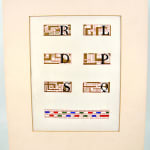François-Louis Schmied
Original lettering designs on vellum, (C. 1920)
(N.p., NP)
1298
Single sheet, which features six bold, serif initials. Each of these has been set in a unique rectangular motif, with red outlines and adornments of gilt both brushed and stippled,...
Single sheet, which features six bold, serif initials. Each of these has been set in a unique rectangular motif, with red outlines and adornments of gilt both brushed and stippled, which all together construct an emblematic Art Deco series of designs. The effort to integrate the muscular, schematic aesthetic of the era into book design evinces the intense appeal of the mode to the interwar spirit. To predicate the details of letterforms on Art Deco and its offshoots was to intimate the style as not only fashionable but democratic. The survival of this particular effort, on this particular substrate, indicates, too, a pivotal period in the development of modern book art. After the Great War, the luxury attitude of Art Nouveau and Arts & Crafts had lost some of its appeal, and the making of handcrafted books no longer was an isolated enterprise but instead became increasingly part of larger art movements. The book-as-medium was taken up by the Surrealists, Dada, and Futurists, as a method of reaching a wider audience, and of exploring ideas beyond the scope of other forms.
The present document also bears hallmarks of the conventions of design, in general, in its assessment of both angular and curvaceous letters, and in the use of a color register at the bottom of the page. Unusual, however, is the use of vellum, an expensive material for a preparatory task.
The style, material, and medium of the piece suggest it as the work of François-Louis Schmied, whose books were expensive to produce, with several executed, at least in part, on vellum. Among these was an edition of the Odyssey; the initials to that production bear similarities with those presented here. It is, then, possible that the piece represents a late-stage test, to compare the success of these designs against another. It seems the latter won out—the present set appears never to have been realized.
A fine sample, representative of a critical period in the history of avant-garde and aesthetic bookmaking. Held in mat. (11 1/4 by 9 3/8 in.; 288x238 mm).
The present document also bears hallmarks of the conventions of design, in general, in its assessment of both angular and curvaceous letters, and in the use of a color register at the bottom of the page. Unusual, however, is the use of vellum, an expensive material for a preparatory task.
The style, material, and medium of the piece suggest it as the work of François-Louis Schmied, whose books were expensive to produce, with several executed, at least in part, on vellum. Among these was an edition of the Odyssey; the initials to that production bear similarities with those presented here. It is, then, possible that the piece represents a late-stage test, to compare the success of these designs against another. It seems the latter won out—the present set appears never to have been realized.
A fine sample, representative of a critical period in the history of avant-garde and aesthetic bookmaking. Held in mat. (11 1/4 by 9 3/8 in.; 288x238 mm).





